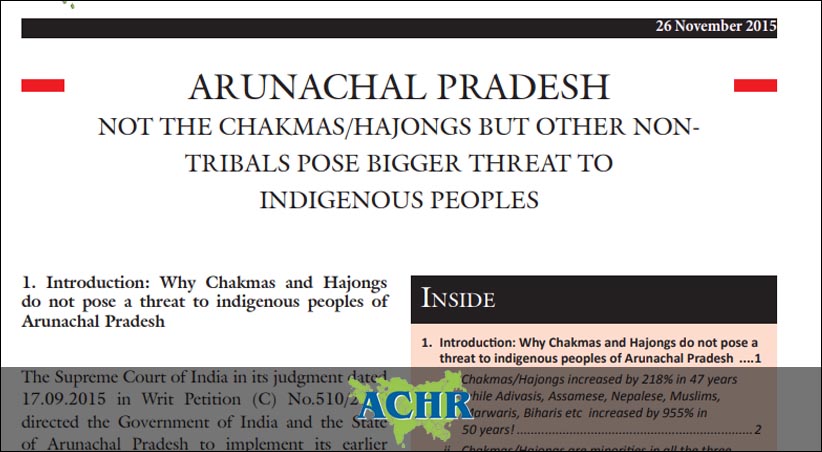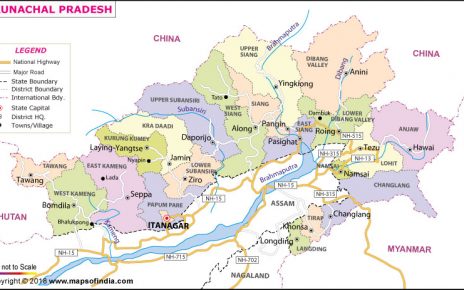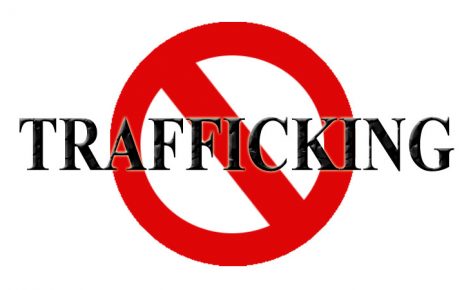New Delhi: Asian Centre for Human Rights in its report, “Arunachal Pradesh: Not the Chakmas/Hajongs but other non-tribals pose bigger threat to indigenous peoples”, today stated that Chakmas and Hajongs of Arunachal Pradesh who had migrated from erstwhile East Pakistan during 1964-1968 do not pose any threat to indigenous peoples of Arunachal Pradesh. The issue of Chakmas and Hajongs posing a threat has come to spotlight following the Supreme Court judgement on 17.09.2015 to implement its 1996 judgement which had directed to process their citizenship applications. Not a single application has been processed since 1996.
The report of the Asian Centre for Human Rights stated population of Chakmas and Hajongs was 14,888 Chakmas/Hajongs during 1964-69 only increased to 47,471 persons as per 2011 census i.e. 218% in 47 years. In comparison, the population of other non-tribals such as Adivasis, Assamese, Nepalese, Muslims, Marwaris, Biharis etc in the State increased by 955% during the same period i.e. from 36,614 persons in 1961 to 3,84,435 persons in 2011 as per the census.
“If the population growth were to pose a threat to indigenous peoples of Arunachal Pradesh, Chakmas/Hajongs surely do not pose a threat to the local indigenous peoples of Arunachal Pradesh. It is the non-Chakma/Hajong general population whose populations have been increasing rapidly. A total of 47,471 Chakmas and Hajongs cannot pose a threat to 13,83,727 persons of the State as per 2011 census”. ” – stated Mr Suhas Chakma, Director of Asian Centre for Human Rights.
Providing details of proof that the Chakmas and Hajongs are minorities in the three districts and four assembly constituencies they are settled, Asian Centre for Human Rights stated Chakmas are currently settled in three districts of Arunachal Pradesh i.e. Namsai, Papumpare and Changlang while Hajongs are settled only in Changlang district.
As per 2011 census, Namsai district had population of 95,950 persons out of which the total population of the Chakmas was only 4,523 persons. In Papum Pare district, the total population was 1,76,573 persons out of which the total population of Chakmas was 2,065 persons. In fact, the populations of the Muslims in Papum Pare district were 6,148 persons i.e. 300% more than the population of the Chakmas in the district. In Changlang district, the total population was 1,48,226 persons out of which the total population of the Chakmas/Hajongs was 40,883 persons.
The Chakmas/Hajongs are settled in four out of 60 Assembly constituencies of Arunachal Pradesh i.e. 49 Bordumsa-Diyun and 50 Miao (ST-Scheduled Tribe) in Changlang district; 46 Chowkham (ST) in Namsai district; and 14 Doimukh (ST) in Papumpare district. As Chakmas/Hajongs are not listed as Scheduled Tribes, they cannot contest the reserved seats for STs i.e. Doimukh (ST), Chowkham (ST) and Miao (ST) Assembly Constituencies. In any case, the Chakmas/Hajongs are minorities in all these constituencies with 2,065 Chakmas out of 60,021 total population in Doimukh (ST) Assembly Constituency; 4,523 Chakmas out of 21,995 population in Chowkham (ST) Assembly Constituency; 10,383 Chakmas/Hajongs out of 44,875 population in Miao (ST) Assembly Constituency. In Bordumsa-Diyun (General) Assembly Constituency, the Chakmas/Hajongs population is 30,619 out of total 61,051 population in the said Assembly Constituency.
In comparison to the Chakmas and Hajongs, other general population of Arunachal Pradesh i.e. Adivasis, Assamese, Nepalese, Muslims, Marwaris, Biharis etc are majorities in three districts and four Assembly constituencies.
As per 2011 census (1) in Papumpare district, non Chakma/Hajong general population i.e. Adivasis, Assamese, Nepalese, Muslims, Marwaris, Muslims, Biharis etc was 57,292 against Chakma/Hajong population of 2,065 persons; in Namsai district, other non-Chakma general population was 59,937 against Chakma/Hajong population of 4,523 while (3) in Changlang district, other non-Chakma Hajong general population was 53,465 against Chakma/Hajong population of 40,883 persons.
As per 2011 census, constituency wise, (1) in Doimukh constituency, out of total 60,021 population, non-Chakma/Hajong general population was 15,583 against 2,065 Chakmas/Hajongs; (2) in Chowkham, out of total 21,995 persons, non-Chakma/Hajong general population was 11,681 against 4,523 Chakmas/Hajongs; (3) in Miao constituency, non-Chakma/Hajong general population was 15,955 against 10,383 Chakmas/Hajongs; and (4) in Bordumsa-Diyun constituency, out of total 61,052 persons, non-Chakma/Hajong general population was 21,468 against 30,619 Chakmas/Hajongs. It is pertinent to mention that only 1500 Chakmas/Hajongs have been included in the electoral roll so far in Bordumsa-Diyun constituency so far.
“The total population of Chakmas in India as per 2011 census was 2,26,860 persons with 96,972 persons in Mizoram; 79,813 persons in Tripura; 2,032 persons in Assam; 466 persons in West Bengal; 106 persons in Meghalaya (as per Census 2011) and 47,471 persons in Arunachal Pradesh. As the Chakmas are recognized as Scheduled Tribe in Assam, West Bengal, Meghalaya, Tripura and Mizoram and there is no reason for the Chakmas from these States to migrate to Arunachal Pradesh where the Chakmas do not enjoy Scheduled Tribe status.” – further stated Mr Chakma.
Further, the potential for increase of other non-Chakma/Hajong general population of Arunachal Pradesh like Adivasis, Assamese, Nepalese, Muslims, Marwaris, Biharis etc is more because of the absence of labour force from indigenous peoples in the State in ever increasing tea industry and infrastructural projects. There were 42 registered Tea Estates, eight Tea Factories and seven Bought Leave Tea Factories in the State as on July 2013 while hundreds of small unregistered tea gardens are abound. All the labourers are Adivasis. Almost all the businesses are controlled by non-tribals from mainland India including Marwaris, Biharis, etc and in Bordumsa Town polling area in Changlang district, out of total 857 voters, 646 are non non-tribals as per 2015 Electoral Rolls.
If the Supreme Court judgment dated 17.09.2015 is fully implemented, it shall mean processing the citizenship applications of about 7,000 surviving Chakmas/ Hajongs who migrated during 1964-69 and whose age is at least 51 years considering the migration took place in 1964. Majority of them are old and fragile, too poor to pay the fees of Rs 5,000 to process the citizenship applications and majority will die soon. Citizenship has almost become meaningless in the twilight of life.
Obviously, processing citizenship applications of about 7,000 Chakmas/Hajongs cannot be a threat to indigenous peoples of Arunachal Pradesh considering the migration of more than 7,000 non-Chakma/Hajong general population in the State every year in search of jobs, business and work in various infrastructure projects.
“Even if processing of citizenship has become almost infractutous for majority of the Chakmas/Hajongs who migrated during 1964-1968, it is still required. Deprived of citizenship or any other identification, many are being denied the freedom of movement – buying a flight ticket or train ticket or checking into a hotel requires identification issued by the government. Nothing could be more humiliating than not having any documentation to prove who you are!” –further stated Mr Chakma.
Asian Centre for Human Rights lamented the decision to further delay integration of the Chakmas and Hajongs by filing review and curative petitions to the Supreme Court judgment dated 17.09.2015 to process citizenship applications. Instead of resolving the problems, the Union of India and the State of Arunachal Pradesh want to drag the problem for political benefits. There is no legal or moral ground to file review or curative petitions. [Ends]



